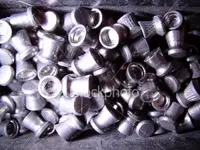You are using an out of date browser. It may not display this or other websites correctly.
You should upgrade or use an alternative browser.
You should upgrade or use an alternative browser.
Squirrel Wars, The Last Straw
- Thread starter Monty
- Start date
Bridge End Farm
Gold Member
Sniffer said:tastes great, less filling LOL
yeap better for you than bacon with eggs mmmmm mmmmm good
Monty
Gold Member
- Joined
- Jan 26, 2005
- Messages
- 10,746
- Reaction score
- 167
- Golden Thread
- 0
- Location
- Sand Springs, OK
- Detector(s) used
- ACE 250, Garrett
- Primary Interest:
- All Treasure Hunting
- #23
Thread Owner
I enjoy watching them in the parks. They'll come right up and eat out of your hands. My grandkids take them peanuts. But the ones that invade my neighborhood are rougues! They chew up what they can't eat. My pellet rifle is a RWS .17 caliber and it gets 1200 fps from the muzzle, or about like a .22 short. At 30 yards I can put almost ten shots in the same hole if I have a good rest. I am always careful to have a good backstop in case I miss, but so far I haven't missed! Be careful if you have to dispatch a few. Monty
Bridge End Farm
Gold Member
1200 fps 
dude thats smoking.
you don't go halfway on anything do you
whats the score

dude thats smoking.

you don't go halfway on anything do you

whats the score
Monty said:I enjoy watching them in the parks. They'll come right up and eat out of your hands. My grandkids take them peanuts. But the ones that invade my neighborhood are rougues! They chew up what they can't eat. My pellet rifle is a RWS .1 caliber and it gets 1200 fps from the muzzle, or about like a .22 short. At 30 yards I can put almost ten shots in the same hole if I have a good rest. I am always careful to have a good backstop in case I miss, but so far I haven't missed! Be careful if you have to dispatch a few. Monty
Monty
Gold Member
- Joined
- Jan 26, 2005
- Messages
- 10,746
- Reaction score
- 167
- Golden Thread
- 0
- Location
- Sand Springs, OK
- Detector(s) used
- ACE 250, Garrett
- Primary Interest:
- All Treasure Hunting
- #25
Thread Owner
Score 8 to 0. M  nty
nty
 nty
ntyI dig it
Jr. Member
- Joined
- Jan 16, 2009
- Messages
- 91
- Reaction score
- 0
- Golden Thread
- 0
- Location
- Vancouver,Washington
- Detector(s) used
- fisher F2 , Minelabs Quattro mp, Whites 6000
The .22 Centerfire Varmint Cartridges
Found one of these the other day while out MDing as the late Paul Harvey would say ,so now you know the rest of the story
The first of the modern .22 varmint cartridges was the .22 Hornet, developed in the 1920's and introduced as a factory loaded cartridge by Winchester in 1930. The modest Hornet, still popular, drives a 45 grain bullet at a MV of 2690 fps.
The latest in the long list of .22 varmint cartridges, as of this writing, is the .223 WSSM, introduced in 2003. The .223 WSSM drives a 55 grain bullet at a MV of 3850 fps. That pretty well summarizes the evolution of the hot .22's. But as sure as the sun rises, there will be more hot centerfire .22's brought to market in the future. It seems as if the interest in this class of cartridge never wanes.
Along the way, and still reasonably popular, the major arms and ammunition companies brought out the .218 Bee (46 grain bullet at 2760 fps), .221 Fireball (50 grain bullet at 2995 fps), .222 Remington (50 grain bullet at 3140 fps), .223 Remington (55 grain bullet at 3240 fps), .22-250 Remington (55 grain bullet at 3680 fps), and .220 Swift (50 grain bullet at 3870 fps).
Remington lists the .223 Remington, .22-250 Remington, and .222 Remington among their 10 best selling centerfire rifle cartridges. This says something about Remington's success in the field as well as the popularity of the centerfire .22's in general.
Other efforts, such as the .219 Zipper, .220 Rocket, .222 Rem. Magnum, .224 Weatherby, and .225 Winchester, had their moment in the sun but failed to achieve lasting popularity. The .224 Wby. and .225 Win. were introduced as factory loaded cartridges around the same time as the immensely popular .22-250. All three are very similar ballistically, but the .22-250 took off and the other two did not.
All of these centerfire .22's were designed for shooting small game, varmints and small predators at long range (meaning beyond the effective range of .22 rimfire cartridges). There seems to be an appeal to varmint hunting that never wanes. Perhaps shooting small rodents satisfies some primordial urge in Homo sapiens. At ranges around 200 yards it is certainly a challenge to both the shooter and the rifle.
Small targets at long range put an emphasis on accuracy. In the right rifle, all of the centerfire .22's can be superbly accurate. The .222 Remington, in fact, is probably the most accurate hunting rifle cartridge ever introduced.
Part of the great appeal of the centerfire .22's is their mild recoil and relatively tame muzzle blast. Even the largest .22 cartridges, the .220 Swift and .223 WSSM, remain fun to shoot over extended periods of time. And because they are easy to shoot, hunters shoot them well.
Larger caliber cartridges, such as the .243 Winchester, 6mm Remington, and .25-06 Remington, can deliver the required accuracy and flat trajectory with varmint bullets, but they kick more and are not as much fun to shoot. Their barrels heat up more rapidly, and their ammunition costs are substantially higher, even for reloaders. All of these factors combine to insure the continuing popularity of the centerfire .22's.
However, I would be remiss if I did not point out that the centerfire .22's do have their weaknesses. Principle among them is the relatively poor ballistic coefficient (BC) and sectional density (SD) of their varmint bullets.
Ballistic coefficient is indicative of aerodynamic drag, or how efficiently a bullet flies through the air. The higher the BC, the better a bullet retains its initial velocity and the flatter it shoots.
Sectional density is the square of a bullet's diameter divided by its weight. A bullet with a high sectional density is a long bullet for its caliber; this helps it penetrate well. Given two bullets of the same basic shape, the one with the higher sectional density will also have the higher ballistic coefficient, so to an extent a superior SD and a superior BC go hand in hand.
Unfortunately, in the modern vernacular, bullets for .22 rifles are SD and BC challenged. In other words, they score pretty low in both areas. That is why at extreme long range a varmint bullet from a .243 may actually shoot flatter than a bullet from a hot .22 that starts with a higher muzzle velocity. The light, relatively short .22 bullet loses velocity faster and at long range may actually be traveling slower than the .243 bullet.
This is also why .22 bullets drift so badly in the wind. Wind drift is a function, not so much of velocity, but of the rate of velocity loss. Again, the larger bore varmint calibers have an advantage over the .22's.
Still, for most varmint shooting most of the time, the centerfire .22's are the way to go. Their mild muzzle blast means that they can be used closer to civilization than the bigger calibers (non-shooters tend to equate noise with danger), and their mild recoil means that more rounds can be fired with greater accuracy over a longer period of time. As much as I appreciate my lovely and accurate Browning 1885 Low Wall .243, for instance, my humble .223 is my favorite varmint rifle with which to put in a long day of shooting.
Found one of these the other day while out MDing as the late Paul Harvey would say ,so now you know the rest of the story
The first of the modern .22 varmint cartridges was the .22 Hornet, developed in the 1920's and introduced as a factory loaded cartridge by Winchester in 1930. The modest Hornet, still popular, drives a 45 grain bullet at a MV of 2690 fps.
The latest in the long list of .22 varmint cartridges, as of this writing, is the .223 WSSM, introduced in 2003. The .223 WSSM drives a 55 grain bullet at a MV of 3850 fps. That pretty well summarizes the evolution of the hot .22's. But as sure as the sun rises, there will be more hot centerfire .22's brought to market in the future. It seems as if the interest in this class of cartridge never wanes.
Along the way, and still reasonably popular, the major arms and ammunition companies brought out the .218 Bee (46 grain bullet at 2760 fps), .221 Fireball (50 grain bullet at 2995 fps), .222 Remington (50 grain bullet at 3140 fps), .223 Remington (55 grain bullet at 3240 fps), .22-250 Remington (55 grain bullet at 3680 fps), and .220 Swift (50 grain bullet at 3870 fps).
Remington lists the .223 Remington, .22-250 Remington, and .222 Remington among their 10 best selling centerfire rifle cartridges. This says something about Remington's success in the field as well as the popularity of the centerfire .22's in general.
Other efforts, such as the .219 Zipper, .220 Rocket, .222 Rem. Magnum, .224 Weatherby, and .225 Winchester, had their moment in the sun but failed to achieve lasting popularity. The .224 Wby. and .225 Win. were introduced as factory loaded cartridges around the same time as the immensely popular .22-250. All three are very similar ballistically, but the .22-250 took off and the other two did not.
All of these centerfire .22's were designed for shooting small game, varmints and small predators at long range (meaning beyond the effective range of .22 rimfire cartridges). There seems to be an appeal to varmint hunting that never wanes. Perhaps shooting small rodents satisfies some primordial urge in Homo sapiens. At ranges around 200 yards it is certainly a challenge to both the shooter and the rifle.
Small targets at long range put an emphasis on accuracy. In the right rifle, all of the centerfire .22's can be superbly accurate. The .222 Remington, in fact, is probably the most accurate hunting rifle cartridge ever introduced.
Part of the great appeal of the centerfire .22's is their mild recoil and relatively tame muzzle blast. Even the largest .22 cartridges, the .220 Swift and .223 WSSM, remain fun to shoot over extended periods of time. And because they are easy to shoot, hunters shoot them well.
Larger caliber cartridges, such as the .243 Winchester, 6mm Remington, and .25-06 Remington, can deliver the required accuracy and flat trajectory with varmint bullets, but they kick more and are not as much fun to shoot. Their barrels heat up more rapidly, and their ammunition costs are substantially higher, even for reloaders. All of these factors combine to insure the continuing popularity of the centerfire .22's.
However, I would be remiss if I did not point out that the centerfire .22's do have their weaknesses. Principle among them is the relatively poor ballistic coefficient (BC) and sectional density (SD) of their varmint bullets.
Ballistic coefficient is indicative of aerodynamic drag, or how efficiently a bullet flies through the air. The higher the BC, the better a bullet retains its initial velocity and the flatter it shoots.
Sectional density is the square of a bullet's diameter divided by its weight. A bullet with a high sectional density is a long bullet for its caliber; this helps it penetrate well. Given two bullets of the same basic shape, the one with the higher sectional density will also have the higher ballistic coefficient, so to an extent a superior SD and a superior BC go hand in hand.
Unfortunately, in the modern vernacular, bullets for .22 rifles are SD and BC challenged. In other words, they score pretty low in both areas. That is why at extreme long range a varmint bullet from a .243 may actually shoot flatter than a bullet from a hot .22 that starts with a higher muzzle velocity. The light, relatively short .22 bullet loses velocity faster and at long range may actually be traveling slower than the .243 bullet.
This is also why .22 bullets drift so badly in the wind. Wind drift is a function, not so much of velocity, but of the rate of velocity loss. Again, the larger bore varmint calibers have an advantage over the .22's.
Still, for most varmint shooting most of the time, the centerfire .22's are the way to go. Their mild muzzle blast means that they can be used closer to civilization than the bigger calibers (non-shooters tend to equate noise with danger), and their mild recoil means that more rounds can be fired with greater accuracy over a longer period of time. As much as I appreciate my lovely and accurate Browning 1885 Low Wall .243, for instance, my humble .223 is my favorite varmint rifle with which to put in a long day of shooting.
Bridge End Farm
Gold Member
Monty said:Score 8 to 0. Mnty








that 8 for you I hope

your getting a good frying pan full

Monty
Gold Member
- Joined
- Jan 26, 2005
- Messages
- 10,746
- Reaction score
- 167
- Golden Thread
- 0
- Location
- Sand Springs, OK
- Detector(s) used
- ACE 250, Garrett
- Primary Interest:
- All Treasure Hunting
- #28
Thread Owner
Dodge dealer says damage is $323.16! About what I figured! Dang squirrel meat cost more than venison! Monty
Bridge End Farm
Gold Member
Monty said:Dodge dealer says damage is $323.16! About what I figured! Dang squirrel meat cost more than venison! Monty
I understand it isn't funny to you and I am sorry but that comment is so true for you.
Monty
Gold Member
- Joined
- Jan 26, 2005
- Messages
- 10,746
- Reaction score
- 167
- Golden Thread
- 0
- Location
- Sand Springs, OK
- Detector(s) used
- ACE 250, Garrett
- Primary Interest:
- All Treasure Hunting
- #32
Thread Owner
Bridge End Farm
Gold Member
Sniffer said:I've used those predators before, they'll even take down a possum
even coons too
Mental Granny
Gold Member
- Joined
- May 8, 2005
- Messages
- 10,072
- Reaction score
- 115
- Golden Thread
- 0
- Location
- Cherokee Strip
- Detector(s) used
- Cibola
- Primary Interest:
- All Treasure Hunting
txkickergirl
Silver Member
- Joined
- Jan 4, 2007
- Messages
- 2,782
- Reaction score
- 25
- Golden Thread
- 0
- Location
- George West, TX
- Detector(s) used
- SOV, EXCAL, CZ20, & more
- Primary Interest:
- All Treasure Hunting
dang sorry about all the mess those pests are creating.
I could loan you my dog, if they are not in the yard she's ok, the moment one invades her yard, its Adios, so long, goodbye, make my day.
Her kills include, birds, squirls, possum, coon, cats, rats. I should know she leaves them by the back door for me.
We had a cat in the neighborhood, it would sit in the middle of the road, she was fine with that she would sit there and watch it but not chase it, if it put one paw over she had that thing running for the trees. It was the funniest thing, because daily those 2 would have their standoff. She never got that cat, a car did, stupid cat wouldn't move from the road guess it finally ran out of its 9 lives.
I could loan you my dog, if they are not in the yard she's ok, the moment one invades her yard, its Adios, so long, goodbye, make my day.
Her kills include, birds, squirls, possum, coon, cats, rats. I should know she leaves them by the back door for me.
We had a cat in the neighborhood, it would sit in the middle of the road, she was fine with that she would sit there and watch it but not chase it, if it put one paw over she had that thing running for the trees. It was the funniest thing, because daily those 2 would have their standoff. She never got that cat, a car did, stupid cat wouldn't move from the road guess it finally ran out of its 9 lives.
Monty
Gold Member
- Joined
- Jan 26, 2005
- Messages
- 10,746
- Reaction score
- 167
- Golden Thread
- 0
- Location
- Sand Springs, OK
- Detector(s) used
- ACE 250, Garrett
- Primary Interest:
- All Treasure Hunting
- #38
Thread Owner
I have several kinds of pellets and settled on the one that was most accurate in my pellet rifle. With this particular one, I can put them into one hole all day long at 30 yds. That's about as good as I have ever been able to shoot and I've never had to fire more than one shot. They drop like hit by lightening and it being so accurate, all my shots are head shots. Oh, and I forgot to mention I use to shoot military bolt action matches with old WWI rifles and won several matches. I also use to do a little trick shooting at thrown objects just to show off, but my reflexes are getting slower. Monty
Mental Granny
Gold Member
- Joined
- May 8, 2005
- Messages
- 10,072
- Reaction score
- 115
- Golden Thread
- 0
- Location
- Cherokee Strip
- Detector(s) used
- Cibola
- Primary Interest:
- All Treasure Hunting
Lowbatts
Gold Member
Thread being moved to Reality TV Show Possibilities very quickly!
Trap shooting squirrels with Monty,
GI Joe Action Sports
C'mon Hollywood!
Trap shooting squirrels with Monty,
GI Joe Action Sports
C'mon Hollywood!
Similar threads
- Suggestion
- Replies
- 6
- Views
- 510
- Suggestion
- Replies
- 13
- Views
- 526
Users who are viewing this thread
Total: 1 (members: 0, guests: 1)








